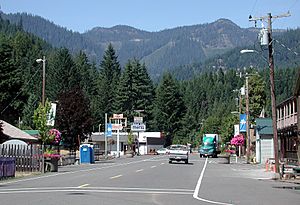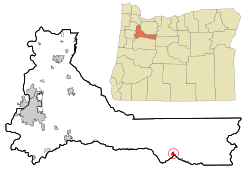Detroit, Oregon facts for kids
Quick facts for kids
Detroit, Oregon
|
|
|---|---|

Looking North along Detroit Avenue in 2009
|
|

Location in Oregon
|
|
| Country | United States |
| State | Oregon |
| County | Marion |
| Incorporated | 1952 |
| Area | |
| • Total | 0.95 sq mi (2.47 km2) |
| • Land | 0.59 sq mi (1.52 km2) |
| • Water | 0.37 sq mi (0.95 km2) |
| Elevation | 1,604 ft (489 m) |
| Population
(2020)
|
|
| • Total | 203 |
| • Density | 346.42/sq mi (133.71/km2) |
| Time zone | UTC-8 (Pacific) |
| • Summer (DST) | UTC-7 (Pacific) |
| ZIP code |
97342
|
| Area code(s) | 503 and 971 |
| FIPS code | 41-19100 |
| GNIS feature ID | 2410330 |
Detroit is a small city in Marion County, Oregon, in the United States. It was named in the 1890s after Detroit, Michigan, because many people from Michigan lived there. In 2020, 203 people lived in Detroit. The city is part of the Salem Metropolitan Statistical Area.
Contents
History of Detroit, Oregon
The original town of Detroit was covered by water in the summer of 1952. This happened when the Corps of Engineers finished building the Detroit Dam on the Santiam River. The community then moved about 0.5 miles (0.8 km) northwest of its first spot. It was rebuilt along Route 22 and officially became a city in 1952.
Building the Detroit Dam
Construction on the Detroit Dam began on April 1, 1949. This dam was part of a bigger project called the Willamette Valley Project. The dam was finished and officially opened on June 10, 1953. It helps control floods, makes electricity, and supports farming and recreation.
Tourism and Challenges
Detroit is located near Detroit Lake and Detroit Lake State Park. Because of this, its economy mostly depends on tourism. In 2001, the area had a bad drought. During that summer, Detroit Lake almost completely dried up, becoming just the Santiam River.
Vote to Change the City's Name
In 2010, citizens in Detroit voted on whether to change the city's name to Detroit Lake. The vote was close, with 47 people voting no and 37 voting yes. The idea came from a builder who wanted to make the town seem different from Detroit, Michigan. He felt that the name Detroit had a negative reputation.
However, the people of Detroit, Oregon, chose to keep their original name. Even so, many locals and visitors still call the area "Detroit Lake."
Recent Events in Detroit
On September 9, 2020, most of Detroit was destroyed by the Santiam Fire. Many people were trapped but managed to escape through a forest road. A few months later, in February 2021, the city got a huge amount of snow. It received 26 inches (66 cm) during a big winter storm.
Geography of Detroit
According to the United States Census Bureau, Detroit covers a total area of 0.96 square miles (2.47 square kilometers). About 0.59 square miles (1.52 square kilometers) is land, and 0.37 square miles (0.95 square kilometers) is water.
Climate
Detroit has warm, dry summers. The average monthly temperatures do not go above 71.6°F (22°C). This type of weather is known as a warm-summer Mediterranean climate.
| Climate data for 1948-1972 Detroit, Oregon. | |||||||||||||
|---|---|---|---|---|---|---|---|---|---|---|---|---|---|
| Month | Jan | Feb | Mar | Apr | May | Jun | Jul | Aug | Sep | Oct | Nov | Dec | Year |
| Mean daily maximum °F (°C) | 40.7 (4.8) |
46.9 (8.3) |
50.3 (10.2) |
58.1 (14.5) |
65.8 (18.8) |
72.4 (22.4) |
81.7 (27.6) |
81.2 (27.3) |
75.2 (24.0) |
62.5 (16.9) |
50.5 (10.3) |
42.8 (6.0) |
60.7 (15.9) |
| Mean daily minimum °F (°C) | 26.9 (−2.8) |
29.7 (−1.3) |
30.5 (−0.8) |
33.9 (1.1) |
40.0 (4.4) |
45.6 (7.6) |
47.9 (8.8) |
47.6 (8.7) |
42.9 (6.1) |
37.8 (3.2) |
32.8 (0.4) |
29.7 (−1.3) |
37.1 (2.8) |
| Average precipitation inches (mm) | 14.23 (361) |
9.95 (253) |
9.07 (230) |
5.05 (128) |
3.71 (94) |
2.35 (60) |
0.52 (13) |
1.19 (30) |
2.99 (76) |
7.60 (193) |
11.86 (301) |
13.99 (355) |
82.51 (2,096) |
| Average snowfall inches (cm) | 31.4 (80) |
13.8 (35) |
14.8 (38) |
1.9 (4.8) |
0.1 (0.25) |
0.0 (0.0) |
0.0 (0.0) |
0.0 (0.0) |
0.0 (0.0) |
0.1 (0.25) |
2.6 (6.6) |
17.2 (44) |
82.1 (209) |
| Source: The Western Regional Climate Center | |||||||||||||
Population of Detroit
| Historical population | |||
|---|---|---|---|
| Census | Pop. | %± | |
| 1960 | 206 | — | |
| 1970 | 328 | 59.2% | |
| 1980 | 367 | 11.9% | |
| 1990 | 331 | −9.8% | |
| 2000 | 262 | −20.8% | |
| 2010 | 202 | −22.9% | |
| 2020 | 203 | 0.5% | |
| U.S. Decennial Census | |||
2010 Census Information
In 2010, there were 202 people living in Detroit. They lived in 96 households, and 59 of these were families. The city had about 342 people per square mile (132 people per square kilometer).
Most of the people in Detroit were White (95.5%). A small number were Native American (1.5%) or from two or more races (3.0%). About 3.0% of the population was Hispanic or Latino.
About 19.8% of households had children under 18. More than half (53.1%) were married couples. The average household had 2.10 people, and the average family had 2.64 people.
The average age in the city was 51.4 years. About 18.3% of residents were under 18. Most residents (48.1%) were between 45 and 64 years old. The population was almost evenly split between males (49.5%) and females (50.5%).
Education
Detroit is part of the Santiam Canyon School District. The schools for students from Detroit are located in nearby Mill City, Oregon.
See also
 In Spanish: Detroit (Oregón) para niños
In Spanish: Detroit (Oregón) para niños


